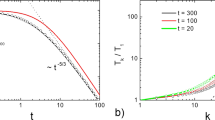Abstract
A theory based on a solution of the inelastic Enskog equation that goes beyond the weak dissipation limit is used to determine the thermal diffusion factor of a binary granular mixture under gravity. The Enskog equation that aims to describe moderate densities neglects velocity correlations but retains spatial correlations arising from volume exclusion effects. As expected, the thermal diffusion factor provides a segregation criterion that shows the transition between the Brazil-nut effect (BNE) and the reverse Brazil-nut effect (RBNE) by varying the parameters of the system (masses, sizes, composition, density and coefficients of restitution). The form of the phase diagrams for the BNE/RBNE transition is illustrated in detail in the tracer limit case, showing that the phase diagrams depend sensitively on the value of gravity relative to the thermal gradient. Two specific situations are considered: i) absence of gravity, and ii) homogeneous temperature. In the latter case, after some approximations, our results are consistent with previous theoretical results derived from the Enskog equation. Our results also indicate that the influence of dissipation on thermal diffusion is more important in the absence of gravity than in the opposite limit. The present analysis, which is based on a preliminary short report of the author (Phys. Rev. E 78, 020301(R) (2008)), extends previous theoretical results derived in the dilute limit case.
Similar content being viewed by others
References
A. Rosato, K.J. Strandburg, F. Prinz, R.H. Swendsen, Phys. Rev. Lett. 58, 1038 (1987).
J.B. Knight, H.M. Jaeger, S.R. Nagel, Phys. Rev. Lett. 70, 3728 (1993).
J. Duran, J. Rajchenbach, E. Clément, Phys. Rev. Lett. 70, 2431 (1993).
W. Cooken, S. Warr, J.M. Huntley, R.C. Ball, Phys. Rev. E 53, 2812 (1996).
T. Shinbrot, F.J. Muzzio, Phys. Rev. Lett. 81, 4365 (1998).
D.C. Hong, P.V. Quinn, S. Luding, Phys. Rev. Lett. 86, 3423 (2001).
S. Luding, E. Clément, A. Blumen, J. Rajchenbach, J. Duran, Phys. Rev. E 50, R1762 (1994).
M.E. Möbius, B.E. Lauderdale, S.R. Nagel, H.M. Jaeger, Nature 414, 270 (2001).
D. Serero, I. Goldhirsch, S.H. Noskowicz, M.-L. Tan, J. Fluid Mech. 554, 237 (2006).
J.J. Brey, M.J. Ruiz-Montero, F. Moreno, Phys. Rev. Lett. 95, 098001 (2005)
V. Garzó, Europhys. Lett. 75, 521 (2006).
J.T. Jenkins, D. Yoon, Phys. Rev. Lett. 88, 194301 (2002).
B. Arnarson, J.T. Willits, Phys. Fluids 10, 1324 (1998).
B. Arnarson, J.T. Jenkins, Phys. Fluids 16, 4543 (2004).
L. Trujillo, M. Alam, H.J. Herrmann, Europhys. Lett. 64, 190 (2003)
J. Jenkins, F. Mancini, J. Appl. Mech. 54, 27 (1987).
A. Barrat, E. Trizac, Granular Matter 4, 57 (2002).
S.R. Dahl, C.M. Hrenya, V. Garzó, J.W. Dufty, Phys. Rev. E 66, 041301 (2002).
V. Garzó, J.W. Dufty, C.M. Hrenya, Phys. Rev. E 76, 031303 (2007).
V. Garzó, C.M. Hrenya, J.W. Dufty, Phys. Rev. E 76, 031304 (2007).
M. Schröter, S. Ulrich, J. Kreft, S.B. Swift, H.L. Swinney, Phys. Rev. E 74, 011307 (2006).
J.E. Galvin, S.R. Dahl, C.M. Hrenya, J. Fluid Mech. 528, 207 (2005).
A.P.J. Breu, H.M. Ensner, C.A. Kruelle, I. Rehberg, Phys. Rev. Lett. 90, 014302 (2003).
V. Garzó, Phys. Rev. E 78, 020301(R) (2008).
A. Prevost, D.A. Egolf, J.S. Urbach, Phys. Rev. Lett. 89, 084301 (2002).
See, for instance, A. Puglisi, V. Loreto, U.M.B. Marconi, A. Petri, A. Vulpiani, Phys. Rev. Lett. 81, 3848 (1998)
J.M. Kincaid, E.G.D. Cohen, M. López de Haro, J. Chem. Phys. 86, 963 (1987).
S. Chapman, T.G. Cowling, The Mathematical Theory of Nonuniform Gases (Cambridge University Press, Cambridge, 1970).
See, for instance, J. Lutsko, Phys. Rev. E 63, 061211 (2001)
D.R.M. Williams, F.C. McKintosh, Phys. Rev. E 54, R9 (1996).
C. Henrique, G. Batrouni, D. Bideau, Phys. Rev. E 63, 011304 (2000).
V. Garzó, A. Santos, Kinetic Theory of Gases in Shear Flows. Nonlinear Transport (Kluwer, Dordrecht, 2003).
See, for instance, J.M. Montanero, V. Garzó, Granular Matter 4, 17 (2002)
R.D. Wildman, D.J. Parker, Phys. Rev. Lett. 88, 064301 (2002)
V. Garzó, J.W. Dufty, Phys. Rev. E 60, 5706 (1999).
A. Santos, J.W. Dufty, Phys. Rev. Lett. 86, 4823 (2001)
T. Boublik, J. Chem. Phys. 53, 471 (1970)
H.-Q. Wang, N. Menon, Phys. Rev. Lett. 100, 158001 (2008).
V. Garzó, J.W. Dufty, Phys. Rev. E 59, 5895 (1999).
J. Lutsko, Phys. Rev. E 72, 021306 (2005).
V. Garzó, F. Vega Reyes, Phys. Rev. E 79, 041303 (2009).
T.M. Reed, K.E. Gubbins, Applied Statistical Mechanics (McGraw-Hill, New York, 1973) Chapter 6.
A. Santos, private communication.
T. Schautz, R. Brito, C.A. Kruelle, I. Rehberg, Phys. Rev. Lett. 95, 028001 (2005).
R.D. Wildman, J.M. Huntley, D.J. Parker, Phys. Rev. E 63, 061311 (2001).
D.K. Yoon, J.T. Jenkins, Phys. Fluids 18, 073303 (2006).
Note that the form of the effective collision frequency $\nu_0$ chosen here differs slightly from the one considered in ref. G08.
Author information
Authors and Affiliations
Corresponding author
Rights and permissions
About this article
Cite this article
Garzó, V. Segregation by thermal diffusion in moderately dense granular mixtures. Eur. Phys. J. E 29, 261–274 (2009). https://doi.org/10.1140/epje/i2009-10488-4
Received:
Revised:
Accepted:
Published:
Issue Date:
DOI: https://doi.org/10.1140/epje/i2009-10488-4




